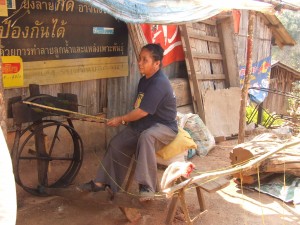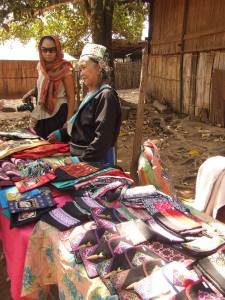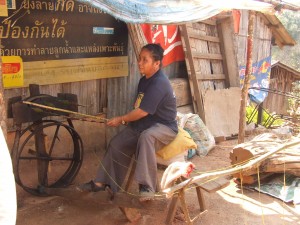 First, a member of this hill tribe took us on a short walking tour of the village. The inhabitants live as they have for generations in simple huts. Families still cultivate crops of staples such as corn, rice and soybeans.
First, a member of this hill tribe took us on a short walking tour of the village. The inhabitants live as they have for generations in simple huts. Families still cultivate crops of staples such as corn, rice and soybeans.
With the assistance of our guide as translator, we were able to speak with a local woman spinning thread outside hers. The thread would be used in the distinctive and intricate handmade Hmong weaving and embroidery they are known for. Of course, fine examples of this colorful work were available for purchase.
 I was suddenly reminded of childhood fairy tales involving spinning wheels. A princess who pricked her finger while spinning wool into yarn, falling into a deep sleep for a hundred years. Apparently, it was just a hobby and no one was relying on her handiwork for their livelihood. A girl spinning straw into gold based on someone else’s greed until she could cleverly gain her release. Fabric is nowhere near as profitable as precious metals.
I was suddenly reminded of childhood fairy tales involving spinning wheels. A princess who pricked her finger while spinning wool into yarn, falling into a deep sleep for a hundred years. Apparently, it was just a hobby and no one was relying on her handiwork for their livelihood. A girl spinning straw into gold based on someone else’s greed until she could cleverly gain her release. Fabric is nowhere near as profitable as precious metals.
Today, machines have taken over textile manufacturing in uniform mass quantities. Garments produced by the thousands in factories are shipped all over the world. But here and now in Thailand, needlework is still done by women in a labor-intensive process with attention to detail.
Remember those young girls waiting. Patience is an important skill in this type of work. These crafts will be passed down to them from their mothers as they were from their grandmothers.

